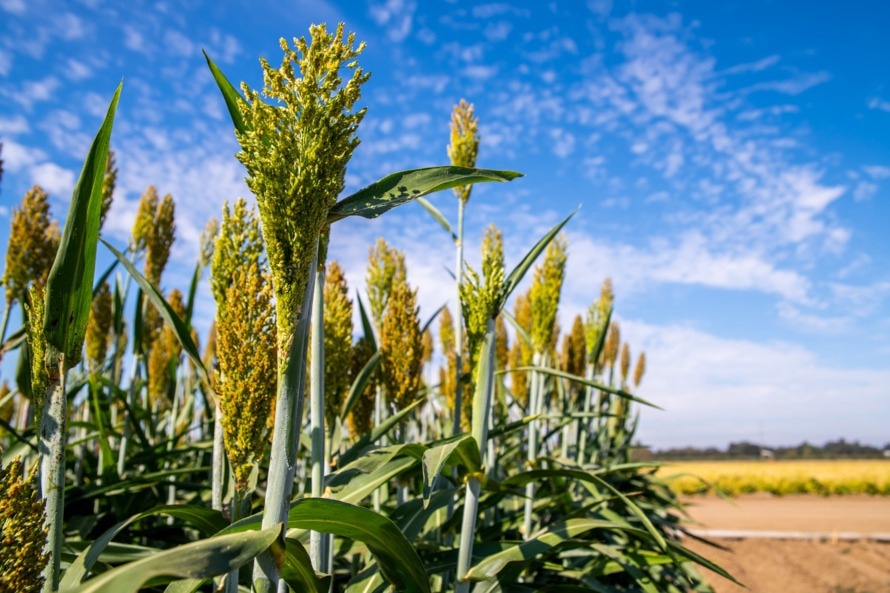For the first time, scientists at the Lawrence Berkeley National Laboratory of the Department of Energy (Berkeley Lab) have created a genome-scale method to map the regulatory role of transcription factors, proteins that are essential for controlling gene expression, and a plant’s physiological features.
 Sorghum is one of JBEI’s target bioenergy crops. Image Credit: Marilyn Sargent/Berkeley Lab
Sorghum is one of JBEI’s target bioenergy crops. Image Credit: Marilyn Sargent/Berkeley Lab
Their research provides previously unattainable insights into gene regulatory networks and identifies a new library of DNA fragments that can be applied to enhance plant genetic engineering efforts.
Transcription factors regulate things like how plants grow, how much fruit they produce, and what their root architecture looks like.”
Niklas Hummel, Study Lead Author and Research Associate, Joint BioEnergy Institute, Department of Energy, Lawrence Berkeley National Laboratory
Hummel added, “By deciphering their regulatory role, we can identify new strategies to engineer more drought-resilient bioenergy crops and other plants with improved agronomic traits.”
Hummel and study senior author Patrick Shih, a faculty member in Berkeley Lab’s Biosciences Area and director of Plant Biosystems Design at Joint BioEnergy Institute, set out to create a technique for simultaneously identifying many transcription factors in a plant.
While methods for doing so exist for other model organisms, including animals, insects, and fungi, applying them to plants has proven difficult due to their complexity and the disruptive presence of cell walls.
To date, these kinds of studies have really been done piecemeal in plants, where we only understood the function of a particular transcription factor because one group of researchers has focused on it for many years. So, what we tried to do instead was come up with a way to map the activity of hundreds of these transcription factors in a plant at the same time.”
Patrick Shih, Study Senior Author and Investigator, Lawrence Berkeley National Laboratory
Hummel and Shih used a temporary expression system they had previously created for developing synthetic biology tools in plants to address this difficulty.
The technology was utilized to define a network of over 400 transcriptional effector domains in the tobacco plant Nicotiana benthamiana in parallel, a feat never before accomplished in plant synthetic biology.
They next conducted a thorough literature analysis to attempt to match the functions of the transcription factors they had discovered in their network collectively with
Shih added, “We were able to show this is what people have seen when they individually studied the role transcription factors play in gene expression, and this is what we have seen when we have studied them in parallel. It actually ended up aligning really well. This makes us confident that we can integrate our dataset into gene regulatory networks to identify key transcription factors for engineering important plant traits.”
The study’s discovery of similar transcriptional regulatory systems in eukaryotes that are only distantly related was one unexpected discovery. The researchers discovered common functionality in the function of transcription factor control in both yeast and plants, demonstrating the existence of highly conserved systems of gene regulation.
“We were surprised to see that many transcription-factor regulatory domains functioned the same across plants and yeast. We then expanded upon this to demonstrate how machine learning algorithms trained on yeast datasets could work to identify regulatory domains in plants,” Hummel added.
The study’s conclusions have significant ramifications for sustainability and agriculture. Since transcription factors play a critical role in determining vital plant features, scientists will be able to design strategies to improve agricultural practices and solve environmental concerns.
In the future, the researchers want to broaden their method to examine all transcription factors in the extensively researched model plant species Arabidopsis. This will promote improvements in the study of plant biology and further expedite the understanding of the regulation of plant-specific genes.
Shih concluded, “Our ability to engineer and modify plants is dependent on our basic understanding of how various traits are regulated. By understanding how key transcription factors may be master regulators of traits of interest, we could identify new strategies to improve bioenergy relevant traits.”
Source:
Journal reference:
Hummel, N. F. C., et al. (2023). The trans-regulatory landscape of gene networks in plants. Cell Systems. doi.org/10.1016/j.cels.2023.05.002